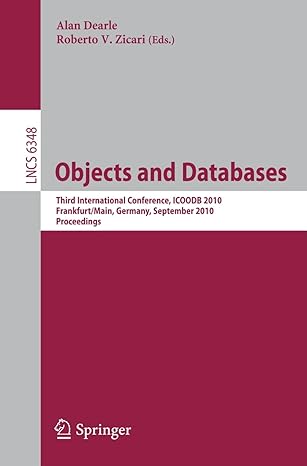Question
Use TensorFlow with Python. The standard example for machine learning these days is the MNIST data set, a collection of 70,000 handwriting samples of the
Use TensorFlow with Python.
The standard example for machine learning these days is the MNIST data set, a collection of 70,000 handwriting samples of the numbers 0-9. Your task is to predict which number each handwritten image represents.
Each image is 28x28 grayscale pixels, so you can treat each image as just a 1D array, or tensor, of 784 numbers. As long as you're consistent in how you flatten each image into an array, it will still work.
Start by importing the data set, which conveniently is part of TensorFlow itself:
import tensorflow as tf
sess = tf.InteractiveSession()
mnist = tf.keras.datasets.mnist
(x_train, y_train),(x_test, y_test) = mnist.load_data()
train_images = x_train.reshape(60000, 784)
test_images = x_test.reshape(10000, 784)
train_images = train_images.astype('float32')
test_images = test_images.astype('float32')
x_train, x_test = train_images / 255.0, test_images / 255.0
y_train = tf.keras.utils.to_categorical(y_train, 10)
y_test = tf.keras.utils.to_categorical(y_test, 10)
MNIST provides 60,000 samples in a training data set, 10,000 samples in a test data set, and 5,000 samples in a "validation" data set. Validation sets are used for model selection, so you use validation data to select your model, train the model with the training set, and then evaluate the model using the test data set.
The training data, after you "flatten" it to one dimension using the reshape function, is therefore a tensor of shape [60,000, 784]: 60,000 instances of 784 numbers that represent each image.
Next, encode the label data as "one_hot" by calling the to_categorical function.
Define a function to visualize what the input data looks like, and pick a random training image to see what it is youre up against:
import matplotlib.pyplot as plt
def display_sample(num):
#Print the one-hot array of this sample's label
print(y_train[num])
#Print the label converted back to a number
label = y_train[num].argmax(axis=0)
#Reshape the 768 values to a 28x28 image
image = x_train[num].reshape([28,28])
plt.title('Sample: %d Label: %d' % (num, label))
plt.imshow(image, cmap=plt.get_cmap('gray_r'))
plt.show()
display_sample(1234)
(Note: Images were generated by the given Python code and, thus, may be included in other literary sources.)
Heres a way to visualize how the data is being fed into the model:
import numpy as np
images = x_train[0].reshape([1,784])
for i in range(1, 500):
images = np.concatenate((images, x_train[i].reshape([1,784])))
plt.imshow(images, cmap=plt.get_cmap('gray_r'))
plt.show()
While training, you'll assign input_images to the training images and target_labels to the training labels. While testing, you'll use the test images and test labels instead.
input_images = tf.placeholder(tf.float32, shape=[None, 784])
target_labels = tf.placeholder(tf.float32, shape=[None, 10])
Now, youll set up your deep neural network. You'll need an input layer with one node per input pixel per image, or 784 nodes. That will feed into a hidden layer of some arbitrary size, so pick 512. That hidden layer will output 10 values, corresponding to scores for each classification to be fed into softmax.
You'll need to reserve variables to keep track of all the weights and biases for both layers:
hidden_nodes = 512
input_weights = tf.Variable(tf.truncated_normal([784, hidden_nodes]))
input_biases = tf.Variable(tf.zeros([hidden_nodes]))
hidden_weights = tf.Variable(tf.truncated_normal([hidden_nodes, 10]))
hidden_biases = tf.Variable(tf.zeros([10]))
Next, feed that into the hidden layer, which applies the ReLU activation function to the weighted inputs with the learned biases added in as well.
Finally, the output layer, called digit_weights, multiplies in the learned weights of the hidden layer and adds in the hidden layer's bias term.
input_layer = tf.matmul(input_images, input_weights)
hidden_layer = tf.nn.relu(input_layer + input_biases)
digit_weights = tf.matmul(hidden_layer, hidden_weights) + hidden_biases
Next, define the loss function for use in measuring progress in gradient descent: cross-entropy, which applies a logarithmic scale to penalize incorrect classifications much more than ones that are close.
loss_function = tf.reduce_mean(tf.nn.softmax_cross_entropy_with_logits_v2(logits=digit_weights, labels=target_labels))
Now, set up the gradient descent optimizer, initializing it with an aggressive learning rate (0.5) and the loss function defined above. That learning rate is an example of a hyperparameter that may be worth experimenting with and tuning.
optimizer = tf.train.GradientDescentOptimizer(0.5).minimize(loss_function)
Next, train the neural network and measure its accuracy. First, define some methods for measuring the accuracy of our trained model.
correct_prediction will look at the output of the neural network (in digit_weights), choose the label with the highest value, and see if that agrees with the target label given.
accuracy then takes the average of all the classifications to produce an overall score for our model's accuracy.
correct_prediction = tf.equal(tf.argmax(digit_weights,1), tf.argmax(target_labels,1))
accuracy = tf.reduce_mean(tf.cast(correct_prediction, tf.float32))
Now, its time to train the model. Set up a TensorFlow session and initialize the variables. Next, train the network in 20 steps (or "epochs") with batches of 100 samples from the training data.
tf.global_variables_initializer().run()
EPOCH = 20
BATCH_SIZE = 100
TRAIN_DATASIZE,_ = x_train.shape
PERIOD = TRAIN_DATASIZE//BATCH_SIZE
for e in range(EPOCH):
idxs = np.random.permutation(TRAIN_DATASIZE)
X_random = x_train[idxs]
Y_random = y_train[idxs]
for i in range(PERIOD):
batch_X = X_random[i * BATCH_SIZE:(i+1) * BATCH_SIZE]
batch_Y = Y_random[i * BATCH_SIZE:(i+1) * BATCH_SIZE]
optimizer.run(feed_dict = {input_images: batch_X, target_labels:batch_Y})
print("Training epoch " + str(e+1))
print("Accuracy: " + str(accuracy.eval(feed_dict={input_images: x_test, target_labels: y_test})))
After you train your model, answer the following questions. You may have to write a Python script to answer a particular question.
What is the accuracy of the model?
What are some of the misclassified images?
How is the accuracy affected by using more hidden neurons? Fewer hidden neurons?
How is the accuracy affected by using different learning rates? Try a range of at least four values.
How is accuracy affected by adding another hidden layer?
How is accuracy affected by using different batch sizes? Try at least three different batch sizes.
What is the best accuracy you can get from this multi-layer perceptron?
Summarize your findings. For each finding, include the Python code and screenshots of the run-time output.
Step by Step Solution
There are 3 Steps involved in it
Step: 1

Get Instant Access to Expert-Tailored Solutions
See step-by-step solutions with expert insights and AI powered tools for academic success
Step: 2

Step: 3

Ace Your Homework with AI
Get the answers you need in no time with our AI-driven, step-by-step assistance
Get Started


